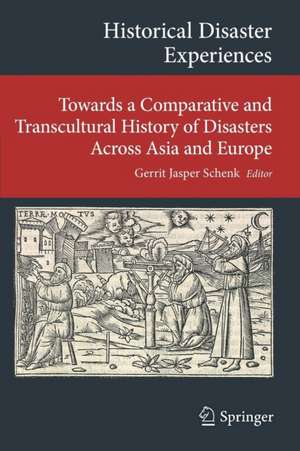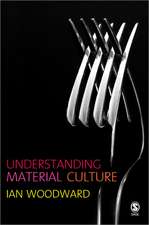Historical Disaster Experiences: Towards a Comparative and Transcultural History of Disasters Across Asia and Europe: Transcultural Research – Heidelberg Studies on Asia and Europe in a Global Context
Editat de Gerrit Jasper Schenken Limba Engleză Paperback – 27 mar 2017
Din seria Transcultural Research – Heidelberg Studies on Asia and Europe in a Global Context
- 18%
 Preț: 948.92 lei
Preț: 948.92 lei - 18%
 Preț: 1216.48 lei
Preț: 1216.48 lei - 15%
 Preț: 637.59 lei
Preț: 637.59 lei - 15%
 Preț: 636.80 lei
Preț: 636.80 lei - 18%
 Preț: 939.46 lei
Preț: 939.46 lei - 15%
 Preț: 648.24 lei
Preț: 648.24 lei - 15%
 Preț: 639.25 lei
Preț: 639.25 lei - 15%
 Preț: 643.34 lei
Preț: 643.34 lei - 15%
 Preț: 640.55 lei
Preț: 640.55 lei - 18%
 Preț: 889.75 lei
Preț: 889.75 lei - 15%
 Preț: 649.54 lei
Preț: 649.54 lei -
 Preț: 419.06 lei
Preț: 419.06 lei - 15%
 Preț: 632.52 lei
Preț: 632.52 lei -
 Preț: 386.99 lei
Preț: 386.99 lei - 15%
 Preț: 636.30 lei
Preț: 636.30 lei -
 Preț: 387.75 lei
Preț: 387.75 lei -
 Preț: 363.52 lei
Preț: 363.52 lei - 18%
 Preț: 784.61 lei
Preț: 784.61 lei - 15%
 Preț: 644.18 lei
Preț: 644.18 lei - 18%
 Preț: 779.57 lei
Preț: 779.57 lei - 15%
 Preț: 584.10 lei
Preț: 584.10 lei - 15%
 Preț: 588.37 lei
Preț: 588.37 lei
Preț: 897.14 lei
Preț vechi: 1094.08 lei
-18% Nou
Puncte Express: 1346
Preț estimativ în valută:
171.72€ • 186.59$ • 144.34£
171.72€ • 186.59$ • 144.34£
Carte tipărită la comandă
Livrare economică 21 aprilie-05 mai
Preluare comenzi: 021 569.72.76
Specificații
ISBN-13: 9783319491622
ISBN-10: 3319491628
Pagini: 397
Ilustrații: IX, 436 p. 121 illus., 44 illus. in color.
Dimensiuni: 155 x 235 x 23 mm
Greutate: 0.62 kg
Ediția:1st ed. 2017
Editura: Springer International Publishing
Colecția Springer
Seria Transcultural Research – Heidelberg Studies on Asia and Europe in a Global Context
Locul publicării:Cham, Switzerland
ISBN-10: 3319491628
Pagini: 397
Ilustrații: IX, 436 p. 121 illus., 44 illus. in color.
Dimensiuni: 155 x 235 x 23 mm
Greutate: 0.62 kg
Ediția:1st ed. 2017
Editura: Springer International Publishing
Colecția Springer
Seria Transcultural Research – Heidelberg Studies on Asia and Europe in a Global Context
Locul publicării:Cham, Switzerland
Cuprins
Part I: State of Research, Concepts and Methods.- Historical Disaster Experiences: First Steps towards a Comparative and Transcultural History of Disasters across Asia and Europe in the Pre-industrial Era.- Living with Hazard: Disaster Subcultures, Disaster Cultures and Risk-Mitigating Strategies.- Part II: Materiality of Disasters: Natural Impact, Social Experience.- Several Natural Disasters in the Middle East (at the Beginning of the Eleventh Century) and their Consequences.- Fanāʾ and Fasād: Perceptions and Concepts of Crises and Disasters in Fourteenth-century Egypt.- The Black Death and Human Impact on the Environment.- The day the sun turned blue. A volcanic eruption in the early 1460s and its possible climatic impact – a natural disaster perceived globally in the late Middle Ages?.- Cultural Implications of Natural Disasters: Historical Reports of the Volcano Eruption of July, 1256 A.D.- When Europe was burning. The multi-seasonal mega-drought of 1540 and the arsonist paranoia.- Part III: Heaven and Earth: Searching for Reasons.- Assur will suffer: Predicting disaster in Ancient Egypt.- ‘Natural’ Disasters in the Arabic Astro-meteorological Malhama Handbooks.- Tracing the Will of the Stars: Indian Astrology and Divination about Natural Disasters and Threats.- Explaining the Bihar Earthquake of 1934: The Role of Science, Astrology and ‘Rumours’.- Part IV: Urban Experience: Earthquakes and Fire.- The 1173/1759 Earthquake in Damascus and the Continuation of Architectural Tradition.- Living with Disaster: Aleppo and the Earthquake of 1822.- ‘The Great Fire in Cairo of 1321’ – Interactions between Nature and Society.- Perceiving Urban Fire Regimes in Europe and China, 1830s to 1870s: British Fire Insurance Businesses and the Sudden Challenge of Globalisation.- Part V: Frequent Experience and Adaptations: Floods and Landscapes of Defence.- Economic adaptation to risky environment in the late Middle Ages. The case of the ‘accrues’ of the Doubs in Chaussin(Jura, France) from c. 1370 to c. 1500.- Measuring ‘disaster’? The ‘everydayness’ of fluvial landscapes and the colonial state in Gangetic diaras, 1790s-1880s.- When the ‘Deluge’ Happened: The Flood of 1929 in the Surma-Barak Valley of Colonial Assam.- Alpine landscapes of defence – On modern-vernacular avalanche protection systems in the Swiss Alps.
Recenzii
“This collection of 20 essays covers a variety of disasters … across a wide expanse of space and time, ranging from the 11th-century Middle East to 16th-century Europe and 20th-century India and Nepal. … The essays are generally of high quality, and several are excellent. Editor Schenk offers a useful introductory overview of the development of historical interest in disasters and key questions that have shaped the field in recent decades … . Summing Up: Recommended, Graduate and research libraries.” (M. Mulcahy, Choice, Vol. 55 (3), November, 2017)
Notă biografică
Gerrit Jasper Schenk (Dr. phil.) is professor of medieval history at Technische Universität Darmstadt (Germany). He has taught at the universities of Heidelberg, Stuttgart and Essen and has held fellowships from the Gerda Henkel Foundation and the German Historical Institutes (Rome, Paris). He is an associated member of the Cluster of Excellence “Asia and Europe in a Global Context” (University of Heidelberg). His main research interests are rituals, ceremonies, pilgrimage, environmental history, historical disaster research and urban history. Most recently he has coedited books on Historical Disasters in Context (2012), Krisengeschichte(n) (2013), Disaster as Image (2014) and Mensch. Natur. Katastrophe. Von Atlantis bis heute (2014).
Textul de pe ultima copertă
Historical disaster research is still a young field. This book discusses the experiences different cultures, from Europe across the Near East to Asia, have of natural disasters. It focuses on the pre-industrial era and on the question of similarities, differences and transcultural dynamics in the cultural handling of natural disasters. Which long-lasting cultural patterns of perception, interpretation and handling of disasters can be determined? Have specific types of disasters changed the affected societies? What have people learned from disasters and what not? What adaptation and coping strategies existed? Which natural, societal and economic parameters play a part? The book not only reveals the historical depth of present practices, but also reveals possible comparisons that show globalization processes, entanglements and exchanges of ideas and practices in preMit bestem Dank im voraus-modern times.
Caracteristici
Presents the first study on historical disaster experiences across Europe, the Near East and Asia in pre-industrial societies Focuses on long-term processes for dealing with natural disasters and on cultural learning Offers transcultural perspectives on historical disaster research










